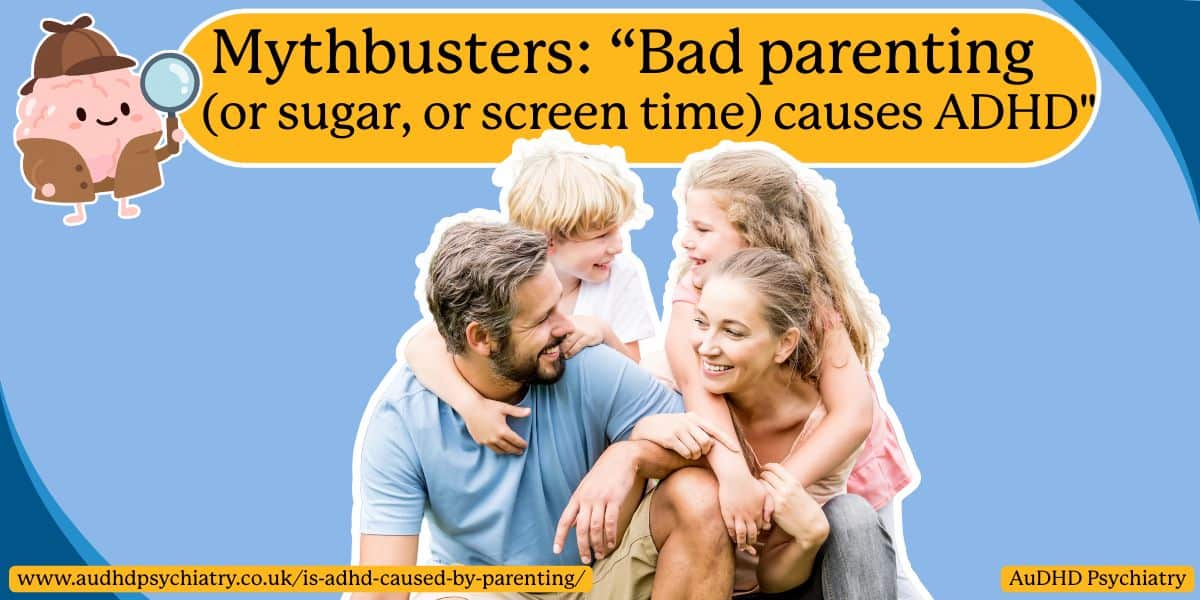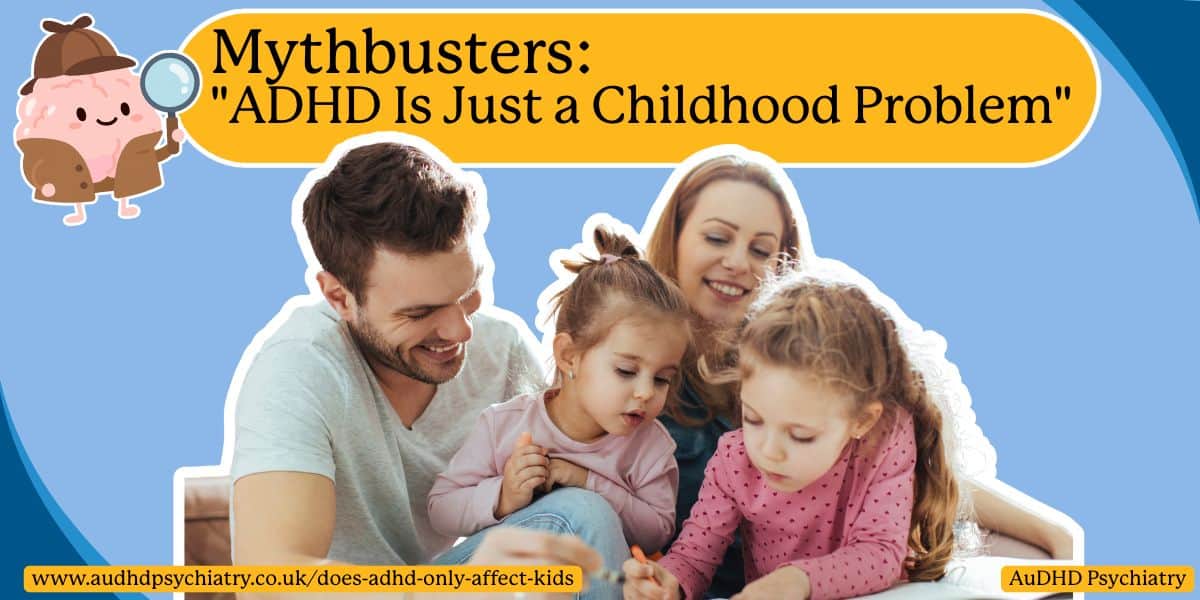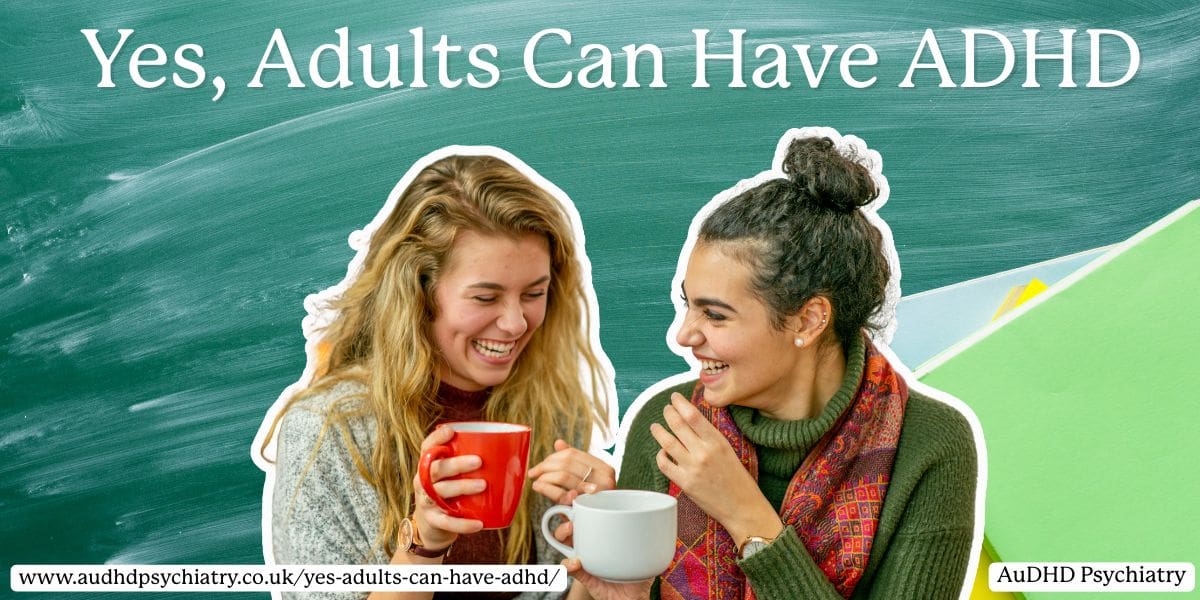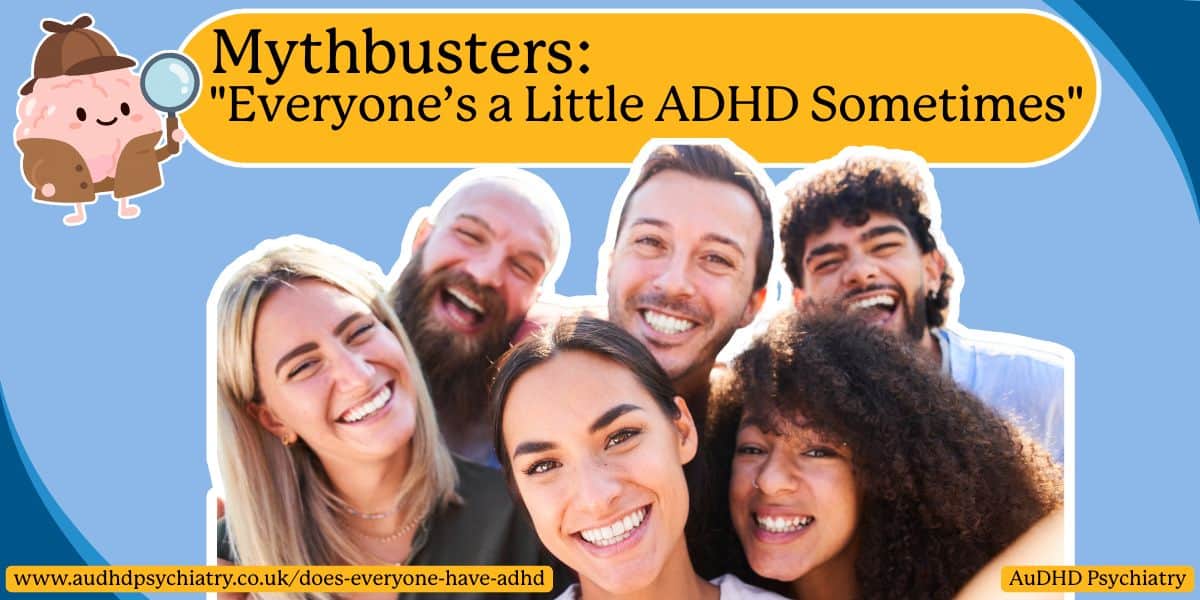
Does Everyone Have ADHD?
Have you heard people say “everyone has ADHD these days”, usually when describing ordinary forgetfulness or inattention? While it may sound harmless, this phrase dismisses the reality of a serious neurodevelopmental disorder that affects daily life for millions of people in the UK.
The truth is that not everyone has ADHD. The condition is defined by clear diagnostic criteria, supported by decades of ADHD research, and recognised in the Statistical Manual of Mental Disorders. It is not simply quirks or bad habits that the vast majority of people experience.
In this article, we’ll explore what people really mean when they say “everyone has ADHD”, how it differs from normal distractibility, and why accurate understanding matters. Along the way, we’ll address ADHD myths, explain how the ADHD brain works, and outline steps toward proper support and diagnosis.
What People Mean When They Say “Everyone Has ADHD”
It is common to hear the phrase “everyone has ADHD” when people describe moments of forgetfulness, inattention, or struggling with an everyday task. Modern life is full of distractions: smartphones, busy schedules, and competing responsibilities. This makes it easy for anyone to feel scattered. But equating this with a medical condition is misleading.
Everyday Quirks vs a Real Disorder
For the vast majority of people, occasional distractibility is part of the human experience. Having a bad day or losing focus in a long meeting does not mean someone has ADHD. The difference is that this condition is a recognised neurodevelopmental disorder that affects a person’s ability to regulate attention and behaviour across their entire life, not just in moments of stress.
Why the Phrase Is Harmful
When people say “everyone has ADHD”, it can:
- Dismiss the real struggles people with ADHD face daily
- Undermine the challenges of neurodivergent adults and children
- Make family members or teachers less likely to notice childhood ADHD symptoms
- Create stigma that ADHD is simply an excuse for careless mistakes
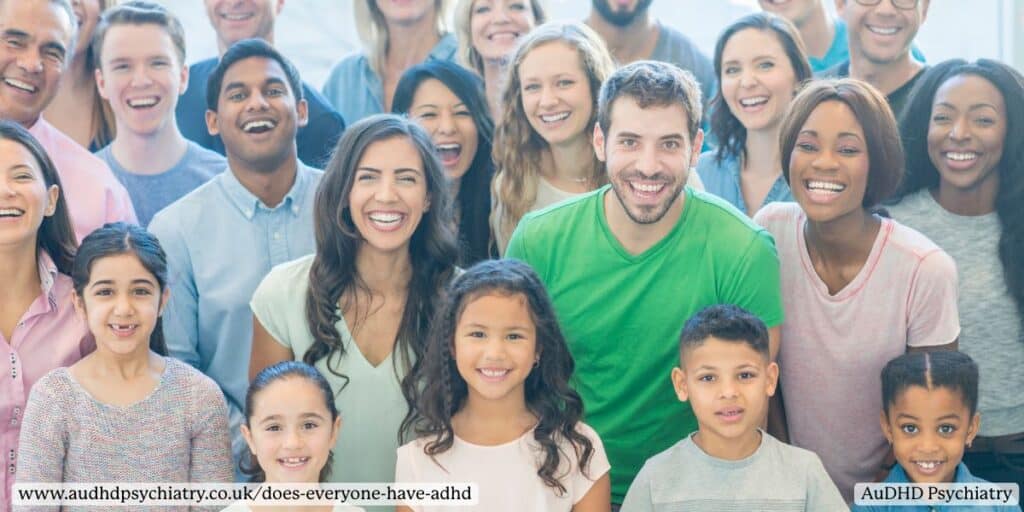
A Condition Across the Lifespan
In reality, adult ADHD is widely recognised, and children diagnosed early often continue to face symptoms as adults. Saying that ADHD is just quirks shared by all minimises the seriousness of a condition that requires assessment, treatment, and support. For clarity on the reality of ADHD, see Yes, Adults Can Have ADHD, which explains how the condition continues beyond childhood.
Everyone forgets things occasionally. Misplacing keys, missing an appointment, or feeling distracted during a long day are not rare experiences. But ADHD goes beyond these normal lapses. It involves consistent patterns of inattention, impulse control issues, and hyperactivity that affect a person’s functioning on a daily basis.
Key Differences Between ADHD and Normal Distraction
- Frequency and intensity: With ADHD, symptoms appear with greater intensity and persistence.
- Life impact: ADHD symptoms disrupt education, work, and relationships, whereas ordinary forgetfulness rarely has lasting consequences.
- Consistency across settings: ADHD difficulties show up in school, at work, and at home, not just in isolated moments.
- Range of symptoms: ADHD involves a spectrum that includes inattentive symptoms, hyperactivity, and poor time management.
Why the Distinction Matters
Confusing ADHD with laziness or normal distraction can delay access to proper support. Many people ask if it is simply a matter of willpower. The answer is no. ADHD is tied to neurobiological differences in the brain.
The Risk of Minimising ADHD
Suggesting that “everyone’s a little ADHD” undermines the need for accurate ADHD diagnoses. It discourages people from recognising sub-threshold symptoms that could develop into real struggles if left unsupported.
Understanding Attention Deficit Hyperactivity Disorder
To move beyond myths, it is essential to know what ADHD really is. Attention deficit hyperactivity disorder is a neurodevelopmental condition defined by diagnostic criteria in the Statistical Manual of Mental Disorders. Unlike occasional lapses in attention, ADHD represents ongoing challenges with self-regulatory functions, which include executive function activities like planning, organising, and sustaining focus.
ADHD as a Brain-Based Disorder
ADHD involves neurobiological differences in the human brain. Studies show altered communication pathways, changes in brain structure, and differences in chemical activity affecting its reward system. These findings demonstrate that ADHD is not a lifestyle issue but a dimensional condition with measurable effects.
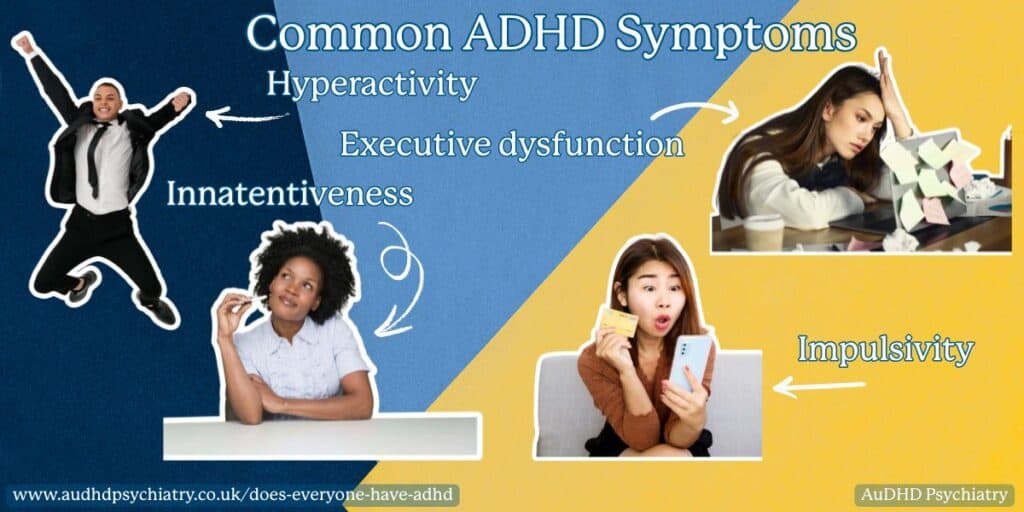
Common Symptoms
The condition includes persistent patterns of:
- Inattention (difficulty sustaining focus, careless mistakes)
- Hyperactivity (restlessness, difficulty sitting still)
- Impulsivity (struggling with impulse control, interrupting others)
These symptoms of ADHD are not just quirks of modern society but indicators of a recognised medical condition that requires intervention.
Treatment Context
While ADHD is lifelong, it can be managed effectively. At AuDHD Psychiatry, treatments include behavioural interventions, therapy, and ADHD medication UK services tailored to individual needs. Understanding the condition is your first step towards exploring how ADHD affects the brain and what options are available for support.
ADHD as a Brain-Based Condition
For years, people debated whether ADHD was simply a matter of poor discipline or the product of modern society. Today, science shows otherwise. ADHD is a neurodevelopmental condition with measurable neurobiological differences in the human brain.
Scientific Perspectives
Research into the brains of people with ADHD highlights differences in communication pathways and chemical activity. The reward system works differently, which helps explain why individuals may struggle with motivation for routine tasks but thrive under urgency or novelty. These are not signs of laziness but of altered executive functioning.
Key Differences in the ADHD Brain
Studies in the field of ADHD show:
- Distinct brain structure differences compared with neurotypical people
- Lower levels of dopamine activity affect impulse control
- Variations in self-regulatory functions contributing to distractibility and inattention
Why Understanding Matters
Viewing ADHD as a dimensional condition with neurobiological differences shifts the conversation from blame to support. It highlights that people with ADHD face real struggles that cannot be overcome through willpower alone. Recognising ADHD as a brain-based disorder also reinforces the need for accurate assessment and effective treatments.
If you’re considering whether you may need support, read our guide on how to get tested for neurodivergence, which outlines the diagnosis of ADHD and next steps in the UK.
The ADHD Spectrum and Executive Functions
ADHD is not one uniform disorder. Instead, it exists on an ADHD spectrum with varying symptom types and severity. This explains why a little bit of ADHD does not capture the full reality. For some, sub-threshold symptoms cause occasional difficulties, while for others the condition disrupts nearly every aspect of their daily life.
The Different Presentations of ADHD
The diagnostic criteria in the Statistical Manual of Mental Disorders identify three main types:
- Inattentive symptoms: disorganisation, forgetfulness, careless mistakes, and weak time management skills
- Hyperactive-impulsive symptoms: fidgeting, restlessness, and poor impulse control
- Combined type: a mixture of both inattentive and hyperactive traits
Each type affects a person’s experiences differently, highlighting ADHD as a dimensional condition rather than a fixed label.

Executive Functions and ADHD
The most significant impact of ADHD lies in weakened executive functions. These self-regulatory functions allow us to manage time, plan, and control behaviour. People with ADHD may experience:
- Time blindness, losing track of minutes or hours
- Analysis paralysis, overthinking decisions until they cannot act
- Difficulties with memory and task prioritisation
- Struggles with rejection sensitivity dysphoria and emotional control
Why Screening Matters
Because symptoms present in different ways, proper screening is vital. Without assessment, people may dismiss their challenges as laziness or personality quirks. But ADHD often requires effective treatments, such as coaching or medication, to improve functioning. If you suspect ADHD, you can explore the Free ADHD Online Test as a first step.
Is ADHD the Same for Kids and Adults?
ADHD struggles do not fade away with age. While childhood ADHD symptoms may be easier to spot in school settings, the challenges often continue into adulthood. The difference lies in how they are expressed at different stages of life.
ADHD Traits in Children
Children with ADHD often show visible hyperactivity and difficulties with attention. Teachers may notice that a child struggles to sit still, blurts out answers, or makes careless mistakes on assignments. Parents may see difficulties with following instructions, managing homework, or organising belongings. These symptoms of ADHD often require support through special education services or special educational needs plans in schools.
Key indicators in children include:
- Restlessness and constant fidgeting
- Forgetting instructions or schoolwork
- Poor impulse control, such as interrupting or acting without thinking
- Trouble sustaining focus during learning activities
ADHD Traits in Adults
In adults, hyperactivity tends to lessen, but problems with executive functioning persist. Adults may struggle with workplace performance, relationship stability, and everyday organisation. Some describe constant overwhelm with everyday tasks and challenges in meeting deadlines.
Untreated ADHD in adults increases the risk of substance use disorder, anxiety disorders, or other conditions, such as mood disorders. Many neurodivergent adults also report inner dysregulation and difficulties balancing family and career.
Adult ADHD symptoms may include:
- Chronic lateness and poor time management
- Disorganisation in work or home life
- Emotional sensitivity, including rejection sensitivity dysphoria
- Difficulty maintaining focus during long tasks
Across the Lifespan
Recognising ADHD across childhood and adulthood is crucial. Left unsupported, the condition can cause negative consequences in education, employment, and relationships. Late diagnosis can also cause internalised issues do to these struggles. But with accurate ADHD assessment and support, children and adults alike can develop strategies for better lives.

Overlooked and Misdiagnosed ADHD
For many years, ADHD was thought of as a condition that primarily affected boys. This stereotype meant that ADHD in women was often ignored, misinterpreted, or dismissed as stress, anxiety, or simply being “scatterbrained.” In reality, women experience ADHD differently, and the symptoms of ADHD are often more subtle but just as disruptive.
Why ADHD Is Missed
Several factors contribute to misdiagnosis in women:
- Inattentive symptoms are more common in women, such as forgetfulness, losing track of time, or appearing daydreamy.
- Women may mask their challenges by working harder to keep up, leading to delayed recognition.
- Emotional difficulties like rejection sensitivity dysphoria or inner dysregulation are sometimes attributed to mood disorders instead of ADHD.
The Real Impact
Because their ADHD is overlooked, many women grow up without support, experiencing:
- Struggles in school despite intelligence and effort
- Low self-esteem from constant comparison to neurotypical people
- Burnout from managing both everyday tasks and masking symptoms
- Delayed ADHD diagnosis, often not until adulthood
Raising Awareness
Greater awareness of ADHD in women helps families, educators, and healthcare providers spot the signs earlier. At AuDHD Psychiatry, we aim to challenge outdated stereotypes and ensure women receive the assessments and support they deserve. To explore this further, see our resource on Hidden Signs of ADD in Women, which highlights how women present differently and why their challenges should not be overlooked.
Hyperfocus, Time Blindness, and Analysis Paralysis
ADHD is often associated with forgetfulness or inattention, but there are other features that many people find surprising. Among them are hyperfocus, time blindness, and analysis paralysis: three aspects that highlight the unique functioning of the ADHD brain.
Hyperfocus
People with ADHD can sometimes enter intense states of focus where hours feel like minutes. Known as hyperfocus, this can be productive in areas of interest but problematic when it causes neglect of other everyday tasks. While neurotypical people may experience similar concentration occasionally, in ADHD it happens with greater intensity.
Time Blindness
Another key difficulty is time blindness. Many with ADHD lose track of minutes and hours, leading to lateness, missed deadlines, and stress. This is not laziness but a result of differences in executive functioning and the brain’s reward system.
Analysis Paralysis
Analysis paralysis occurs when overthinking prevents decision-making. Combined with poor impulse control, it can create a cycle of starting tasks late or abandoning them entirely. This may lead to missed deadlines and might cause an individual to feel inadequate.
Practical strategies include:
- Using timers and reminders to combat time blindness
- Breaking tasks into small steps to reduce paralysis
- Structured techniques such as the Pomodoro method

Emotional and Behavioural Dimensions of ADHD
ADHD is not only about attention. It also shapes how emotions are experienced and expressed. Many adults and children with ADHD report heightened sensitivity, known as rejection sensitivity dysphoria, along with difficulties managing frustration, stress, or inner dysregulation. These challenges can create strain in relationships and reduce confidence in daily life.
Symptoms such as impulse control issues, irritability, or racing thoughts can make everyday interactions feel overwhelming. Without support, these emotional struggles may lead to anxiety disorders, mood disorders, or burnout.
At AuDHD Psychiatry, we help patients manage both the emotional and behavioural aspects of ADHD. From identifying triggers to exploring evidence-based therapy, our team provides pathways to stability. For more on this topic, see Beginner’s Guide to ADHD and Emotional Dysregulation.
Myths About ADHD That Harm Understanding
Misconceptions about ADHD have persisted for decades, creating stigma and preventing people from seeking help. From the claim that “everyone’s a little ADHD” to suggestions that it is caused solely by environmental factors, these myths overshadow the scientific perspectives that define ADHD as a legitimate neurodevelopmental disorder.
Common ADHD Myths
- ADHD is not real: Disproven by decades of ADHD research and recognition in the Statistical Manual of Mental Disorders.
- ADHD is just laziness: In reality, it is tied to differences in executive functions and brain structure.
- ADHD only affects children: Adults also struggle, often with time blindness, poor impulse control, and workplace performance issues.
- ADHD is overdiagnosed: In fact, groups like young women and neurodivergent adults are often underdiagnosed.
The Cost of Believing Myths
Believing myths has been seen to lead to negative consequences:
- Delays in accurate ADHD diagnoses
- Families dismissing childhood ADHD symptoms as quirks
- Adults avoiding assessment due to fear of stigma
- Reduced willingness to seek effective treatments
Breaking Down Misunderstanding
The truth is that ADHD is a real disorder supported by decades of scientific evidence and ongoing neurological studies. Dispelling myths allows people to recognise real struggles rather than dismissing them as part of normal behaviour.
The Importance of Accurate ADHD Diagnosis
A casual phrase like “everyone has ADHD” often discourages people from seeking the right help. But without an accurate ADHD diagnosis, many continue to struggle unnecessarily. Diagnosis is the first step in confirming ADHD and ruling out other mental health conditions.
At AuDHD Psychiatry, our assessments follow recognised diagnostic criteria. We provide thorough evaluations for both adults and children, ensuring patients receive the right diagnosis and clear next steps for treatment. Whether you’re considering a private route or weighing NHS options, our resources can help. Getting clarity changes lives. Patients can move forward with effective treatments and lasting support.
Does Everyone Have ADHD: Conclusion
Living with ADHD means navigating challenges in education, work, and relationships. Fortunately, structured support can make a significant difference. Workplace accommodations such as flexible schedules, task management tools, and coaching help employees improve performance. In schools, special education services and supportive teachers can help young people reach their potential.
At AuDHD Psychiatry, we not only provide assessments but also guidance for managing ADHD in daily life. For practical help, book an assessment with us today. With the right diagnosis and personalised plan, ADHD does not have to limit your future. It can be properly managed, and you can thrive.
You Might Also Like
Contact Us
We’re here to help. Reach out and we’ll get back to you as soon as possible.
Contact Us
We’re here to help. Reach out and we’ll get back to you as soon as possible.

